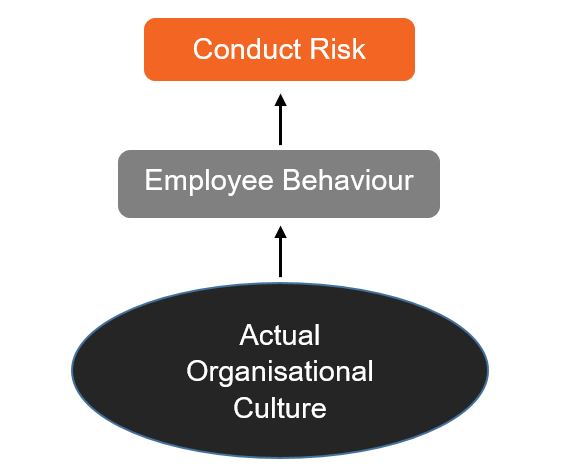Authors: Ian Doyle
Why are standard culture reviews, culture change programs or engagement surveys not the answer to mitigating conduct risk?
The Australian Prudential Regulation Authority Prudential Inquiry into the Commonwealth Bank of Australia,1 the Royal Commission into Misconduct in the Banking, Superannuation and Financial Services Industry2 and the Royal Commission into Aged Care Quality and Safety3 essentially shared a view that culture is at the heart of organisational performance and that aberrant behaviour is unacceptable and must stop.
This should provide a strong signal to all boards, irrespective of industry or sector, of the need to closely examine an area that may not have received sufficient attention in the past, being the organisation’s particular culture and the extent to which it has the potential to create aberrant behaviour. Given the number of boards and executive teams that have been caught unaware by behavioural problems, a top priority should be identifying the potential for poor behaviour so that proactive steps can be taken to manage and mitigate the consequences of that behaviour.
Historically, when boards have considered how to manage unacceptable behaviour and whether a culture review might be an appropriate course of action for their organisation, they concluded that such a review is not necessary because either a culture change program may already be under way or that regular employee engagement surveys will suffice. It is our contention that a culture review, a change program or an employee engagement survey are not effective solutions to provide clear, diagnostic insight into the current and future risks facing an organisation as a result of a poor culture. Nor do these solutions adequately assist organisations to identify immediate actions that can be taken to address
these risks.
The answer is not a standard culture review.
The conclusion of many culture reviews is a description of the inherent nature of an organisation. For example, a culture review may evaluate organisational dimensions such as “people focus” versus “task focus”, “internal focus” versus “external focus” or identify the organisation as being “caring” versus “results-driven”.
The primary output is essentially a high-level description of organisational “personality”. This may be appropriate for informing the broad direction of a culture change program but falls well short of identifying current or future conduct risks.
The answer is also not a culture change program.
It is not suggested that a culture change program is not a good idea. However, this is likely to involve a minimum of 3-year commitment that will require absolute consistency in both leadership behaviour and systems alignment to achieve real results. Even then, there is no certainty about if, or when, the culture change will progress sufficiently to control actual or potential aberrant behaviour. Less than one-third of culture change programs are successful.4
Nor is the answer an engagement survey.
An engagement survey is a useful tool because there is a strong link between the culture of the organisation and the engagement of the people within it. However, an engagement survey has a very specific purpose — to identify the level of commitment employees have in relation to the organisation and to what extent they are prepared to apply discretionary effort5 (being, the difference in the level of effort one is capable of bringing to an activity or a task, and the effort required only to get by or make do). What an engagement survey is not designed to do is to identify aberrant behaviour.
The answer to mitigating aberrant behaviour is understanding conduct risk.
Employee behaviour is significantly influenced by the culture of an organisation, or in other words, “the way things are done around here”. Employee behaviour is the single biggest driver of conduct risk, which can be defined as the “uncertainty and potential for loss due to unsanctioned behaviour or decisions of employees”. So, to have any chance of successfully mitigating aberrant behaviour, it is essential to understand the relationship between culture, employee behaviour and conduct risk (see diagram 1).
Diagram 1 – The relationship between culture, behaviour and conduct risk
Through the identification and observation of employee behaviour, boards can be provided with clear insight into the resultant conduct risk profile of the organisation and proactive initiatives to manage and mitigate these risks.
A well-structured conduct risk analysis needs to have a solid foundation in research and provide predictive validity. Many culture reviews are based on interviews and observations, and as a result, are inherently subjective rather than providing data and meaningful insight into the underlying causes of conduct risks. A board and executive team need a clear data that shows the causes of conduct risk to have any chance of controlling aberrant behaviour and mitigating conduct risk.
In summary, a culture review, a culture change program or an engagement survey are all very worthwhile, meaningful tools and serve particular purposes. However, for boards seeking to avoid being exposed as the next corporate scandal, the focus of regulators or unwanted negative media, understanding their organisation’s particular conduct risks is critical and a well-structured conduct risk analysis may enable them to quickly move to address them.
Footnotes
1 J Laker, J Broadbent and G Samuel Prudential Inquiry into the Commonwealth Bank of Australia Final Report (2018) www.apra.gov.au/sites/default/files/CBA-Prudential-Inquiry_Final-Report_30042018.pdf.
2 K Hayne Royal Commission into Misconduct in the Banking, Superannuation and Financial Services Industry Final Report
(2019) www.royalcommission.gov.au/royal-commission-misconduct-banking-superannuation-and-financial-services-industry.
3 Royal Commission into Aged Care Quality and Safety Care, Dignity and Respect Final Report (1 March 2021) https://agedcare.royalcommission.gov.au/publications/final-report.
4 R Lyons “Three Reasons Why Culture Efforts Fail” Forbes 27 September 2017 www.forbes.com/sites/richlyons/2017/09/ 27/three-reasons-why-culture-efforts-fail/?sh=45cebc1ee077.
5 K Kruse “What Is Employee Engagement” Forbes 22 June 2012 www.forbes.com/sites/kevinkruse/2012/06/22/employee-engagement-what-and-why/?sh=3b93f1157f37.

